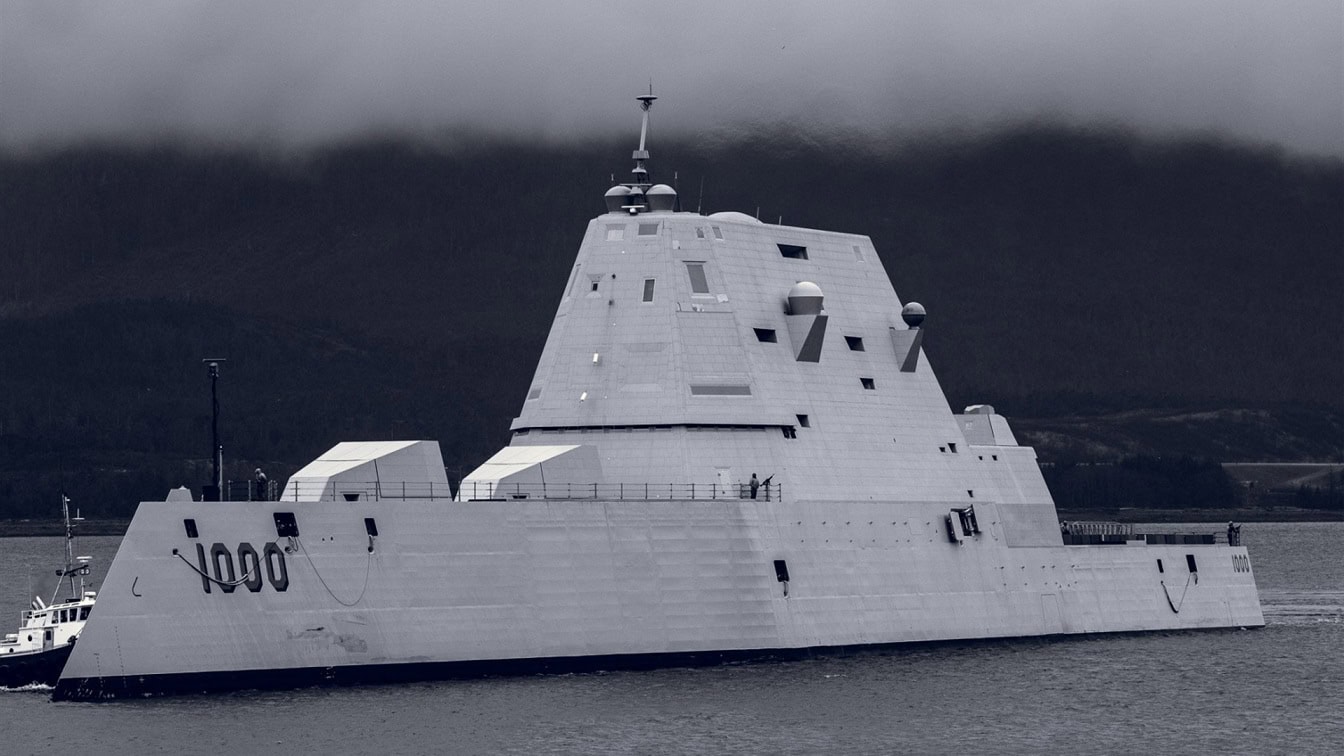Summary and Key Points: The U.S. Navy’s Zumwalt-class destroyers, designed for stealth and advanced naval warfare, faced setbacks when their innovative gun systems proved prohibitively expensive.
-However, a promising retrofit program is converting these ships into hypersonic missile platforms under the “Conventional Prompt Strike” initiative.
-Each Zumwalt destroyer will now carry 12 hypersonic missiles, capable of speeds around MACH 7 or MACH 8, providing critical standoff strike capabilities against adversaries like China and Russia.
-Despite high costs, this upgrade revitalizes the troubled Zumwalt program, giving it new strategic importance by enabling it to counter advanced missile threats and reaffirm U.S. naval dominance in contested waters.
That 1 Word: Hypersonics.
The three destroyers of the next generation Zumwalt-class are designed to be stealthy. They can evade radar and sneak up on the enemy and fire what was supposed to a newfangled and intrepid gun system.
However, the twin turrets of the cannon were never built due to their high expense, so a defense contractor in Mississippi is retro-fitting the ship with hypersonic missiles.
The Navy believes the Zumwalt can now stay out of range of anti-ship missiles and fire the hypersonic at foes without being discovered.
The Troubled Program Could Use Some Good News
The Zumwalt-class has suffered ups and downs with some believing that the failed gun system and other maladies could have ended the life of the destroyer.
“It was a costly blunder. But the Navy could take victory from the jaws of defeat here and get some utility out of them by making them into a hypersonic platform,” said Bryan Clark, a defense analyst at the Hudson Institute.
Can This Shipborne System Even Score with U.S. Adversaries?
The United States had earlier fallen behind China and Russia in the hypersonic missile sweepstakes, but now the country is catching up and numerous models are being tested. China has leapt ahead with its DF-27 nuclear-capable hypersonic weapon and that gives American battle planners and intelligence analysts fear that the Zumwalt-class was never going to catch up.
The concept the Navy is executing with the Zumwalt is called “Conventional Prompt Strike.” The idea is to fire the missile and then have a hypersonic glide vehicle emerge that could fly MACH 7 or MACH 8. This projectile would be maneuverable in air and evade enemy missile defenses.
The Zumwalt-class would receive four missile tubes with three hypersonic missiles on each ship. This would give the flotilla 12 hypersonic missiles that could teach China and Russia a master class on new weapons development on warships.
The Conventional Prompt Strike system is being developed by the Navy and Army.
Expensive Ship That Irked the Naval Bean Counters
This is good news for the Zumwalt-class as it has many detractors in Congress and in naval analysis circles who believe the ship-building program was a waste of money. Each warship cost $7.5 billion. That money could have gone to the Ford-class carrier program or the Columbia-class ballistic missile SSBN submarine instead.
One big disappointment with the Zumwalt was its troubled gun system. This newfangled weapon was supposed to support a force of marauding Marine Corps leathernecks attempting an amphibious landing. But the large rocket-assisted 155mm cannon shells cost almost $1 million each.
The Zumwalt still has enormous potential and has served as a valuable technology test bed. “Those innovations include electric propulsion, an angular shape to minimize radar signature, an unconventional wave-piercing hull, automated fire and damage control and a composite deckhouse that hides radar and other sensors,” according to Defense News.
The Waiting and Expense Could Be the Undoing for the Zumwalt-class
The hypersonic weapon will be tested in 2027 or 2028 after the complete retrofit. But once again, Conventional Prompt Strike will have a high expense. It could cost around $18 billion to buy 300 hypersonic weapons and maintain them for the next two decades.
This is the last gasp for the Zumwalt-class. It needs something to boost the program and establish that it is still a difference maker in naval warfare and not just an experimental test bed for unproven technologies.
The whole thing has been somewhat of a boondoggle, and if these new weapons do not work or are delayed, the doom sayers will be out in force.
This missile could be more expensive than the target it is trying to destroy, so what’s the point?
But it is good news that the Navy is not giving up on the Zumwalt-class and is betting on the hypersonic missile to even the score in East Asia. This could make an impact in any future confrontation with China and Taiwan at each other’s throats.
The Navy will need something that makes it stand apart and the Conventional Prompt Strike program could be that magic bullet that gives proponents of the Zumwalt-class ammunition to keep the ship in business.
About the Author: Dr. Brent M. Eastwood
Brent M. Eastwood, PhD is the author of Don’t Turn Your Back On the World: a Conservative Foreign Policy and Humans, Machines, and Data: Future Trends in Warfare plus two other books. Brent was the founder and CEO of a tech firm that predicted world events using artificial intelligence. He served as a legislative fellow for U.S. Senator Tim Scott and advised the senator on defense and foreign policy issues. He has taught at American University, George Washington University, and George Mason University. Brent is a former U.S. Army Infantry officer. He can be followed on X @BMEastwood.

